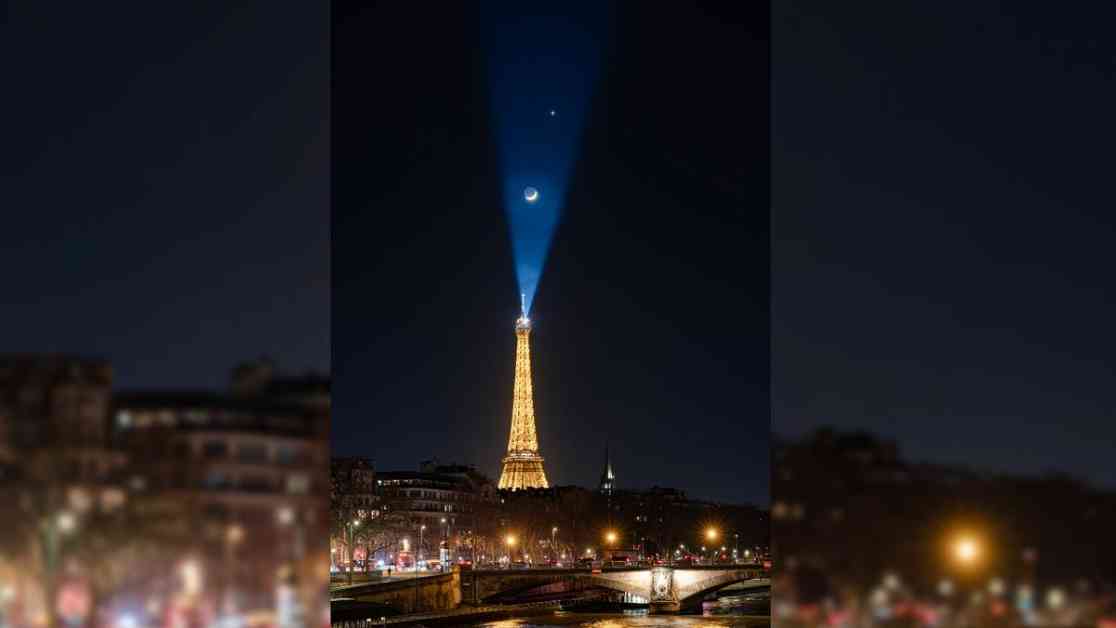Stunning ‘Planetary Parade’ Photo: Venus & Moon Over Eiffel Tower
A breathtaking scene unfolded in the night sky over Paris as Venus and the moon aligned in a captivating celestial display, stealing the spotlight from the iconic Eiffel Tower. The remarkable photograph, captured by French astrophotographer Gwenaël Blanck, showcases the moon and Venus in near-perfect alignment, with a radiant blue beam shooting into the sky from the Eiffel Tower. This rare convergence of planets, known as a “parade of planets,” is set to reach its peak later this month, offering skywatchers a celestial spectacle to behold.
Gwenaël Blanck’s Perspective
Gwenaël Blanck, the mastermind behind the striking image, shared his experience of capturing this celestial event on Instagram. “This is one of the rare celestial events that make people look up even under light-polluted skies,” he wrote. As he set up his equipment on the banks of the Seine river around 8:00 p.m. local time on Feb. 1, Blanck noticed the moon and Venus drawing the attention of tourists and passers-by. While the moon and Venus were easily visible, Saturn, appearing as a faint spot to the right of the Eiffel Tower, proved more elusive to the naked eye due to light pollution. Blanck’s keen eye and expertise in astrophotography allowed him to capture this extraordinary moment for all to admire.
The Earthshine Phenomenon
Blanck’s photograph also captures Earthshine, a striking phenomenon where the dark portions of the moon’s Earth-facing side are illuminated by sunlight reflected off our planet. This mesmerizing effect, most prominent in the Northern Hemisphere during spring, adds an ethereal glow to the moon’s crescent shape. Blanck’s meticulous attention to detail in capturing Earthshine enhances the overall beauty and complexity of the image, inviting viewers to appreciate the intricate interplay of celestial bodies in the night sky.
Planetary Parade: A Celestial Spectacle
The ongoing planetary alignment event, featuring Mercury, Venus, Mars, Jupiter, and Saturn visible to the naked eye, promises a celestial show unlike any other. While Uranus and Neptune also make an appearance in the night sky, they require a telescope for optimal viewing alongside their brighter counterparts. This cosmic parade has already generated excitement among stargazers, with a recent alignment of six planets in late January foreshadowing the grand spectacle to come in late February and early March. During this peak period, all seven planets will align in a near-straight line along the horizon, creating a visual feast for skywatchers worldwide.
Venus: The Brightest Star of the Show
As the brightest planet in the night sky during this planetary parade, Venus shines brightly alongside the moon, making it a standout feature on clear evenings. Its proximity to the moon enhances its visibility, offering a captivating sight for those eager to witness the wonders of the cosmos firsthand. To fully experience the magic of the planetary parade, experts recommend using a quality telescope or stargazing binoculars to enhance your viewing experience and appreciate the intricacies of each celestial body.
Looking Ahead to Future Alignments
While the current planetary alignment event dazzles spectators with its celestial dance, the next opportunity to witness a similar phenomenon won’t occur until October 2028. As astronomers and skywatchers alike eagerly anticipate this rare convergence of planets, the current planetary parade serves as a reminder of the beauty and mystery of the universe that surrounds us. So, take a moment to look up at the night sky, marvel at the celestial wonders above, and immerse yourself in the awe-inspiring spectacle of the cosmos.










